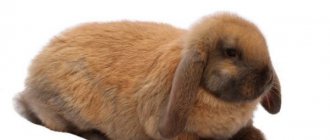Red urine in a rabbit is one of the symptoms that may indicate an animal illness, stress or poor diet. The most dangerous is urine with bloody spots - it can indicate that the animal has cancer, polyps, or severe inflammatory processes in the kidneys. In this article, we will look at the reasons why a rabbit’s urine may acquire a red tint, whether such a symptom indicates the presence of a particular disease, how to properly deal with it using medication and folk methods, and also what other color of urine in animals should cause concern from the rabbit breeder so that he contacts a veterinarian.
Reasons for what it means if a rabbit pees red or brown urine
Red urine in rabbits can be caused by various factors. Among them:
- acute lack of fluid;
- taking antibiotics by animals;
- change in temperature in the enclosure;
- stress in the animal, including those associated with the appearance of new animals in the enclosure.
- weather change;
- infectious diseases of the genitourinary system, such as: spirochetosis, mastitis, vgbk;
- polyps in the genitourinary system;
- the presence of malignant tumors in the kidneys.
How to make a cage for rabbits, read the link.
Also, in rabbits, the urine may turn red after the animal eats carrots. This symptom usually appears within a few hours after consuming such a product. This is not considered a pathology.
If your pet's urine returns to a normal color after removing carrots from its diet, a visit to the veterinarian can be postponed. If this did not happen, then other factors were at play.
Also read about the Black and White breed of cows in this material.
Causes
Red urine can be a consequence of both a disease and causes that do not threaten the life and health of the rabbit.
Diseases
In case of diseases, discharge changes its color most often due to blood - noticeable, recognizable traces of blood appear in the urine. They can be distinguished by the presence of streaks with clearly visible boundaries, or they are isolated droplets of blood of different sizes. In this case, redness of urine is caused by:
- kidney diseases;
- bladder diseases;
- liver damage;
- pathologies of the reproductive system.
Almost any kidney disease in rabbits can lead to such symptoms. However, the most common causes are the following diseases:
- Infection. Encephalozoonosis is one of the most common infections that eared pets are exposed to. It affects many organs and systems of rabbits, including an extremely negative effect on the functioning of the urinary system, as a result of which the color of urine may change.
- Stones in the kidneys. This disease poses a great danger to the health of the rabbit. In some cases, even kidney removal is indicated. However, this is a very delicate issue that requires an individual approach to each case.
- Cancer. The most dangerous and, alas, incurable kidney disease, ultimately leading to death if surgery is not performed. However, there is good news - it is quite rare in rabbits and even more rarely causes blood in the animal’s urine.
If within three days the rabbit's discharge has not acquired a natural color, it is time to make an appointment with the veterinarian.
Bladder diseases also lead to a change in the natural color of urine to red, and it is not difficult to recognize them in rabbits. If your pet begins to spend more time urinating, sitting on the toes of its hind paws, and the amount of discharge can be counted drop by drop, most likely the cause of red urine is one of the following diseases:
- Hypercalciuria. Sand in the bladder irritates the organ and often causes cystitis. In this case, sediment, frequent urge to urinate, wet genitals and urinary incontinence are added to the red discharge.
- Polyps in the bladder. A polyp is a benign tumor that can develop into malignant (cancer). The neoplasm compresses blood vessels and disrupts blood circulation in the urinary system. As the tumor grows, it interferes with the flow of urine, which leads to further inflammation and the appearance of blood during bowel movements.
- Bladder cancer. As with kidney cancer, a rare but disappointing cause of red urine.
- Cystitis. Inflammation of the bladder occurs as a result of many factors and in itself it also causes the urine to change color from yellow to red due to inclusions of blood.
See also Treatment of diarrhea in rabbits at home
Liver problems can make your rabbit's urine red. However, in this case, this is not due to the appearance of blood, but due to chemical elements such as urobilinogen and bilirubin. In extremely rare cases, increased levels of these substances also lead to a change in the color of the fluid secreted by the rabbit.
The last reason dangerous to the health and life of a pet is pathologies of the reproductive system of unsterilized animals. In this case, the discharge becomes darker due to the fact that during the process of urination, blood from the uterus or vagina of the rabbit enters the liquid. These consequences lead to:
- endometrial hyperplasia - an increase in the thickness of the mucous layer of the uterus;
- infections – encephalozoonosis, complication of cystitis, etc.;
- benign and malignant formations in the uterus;
- miscarriage.
Other reasons
Rabbit diseases are not the only factor that can lead to darkening and redness of urine. There are a number of significantly less dangerous reasons:
- Nutrition. Plant pigments found in the food your rabbit eats can add orange and red hues to the urine. In healthy rabbits, porphyrin, beta-carotene and some other plant pigments lead to this reaction. If in the last 24 hours your pet has eaten carrots, beets, spinach, sorrel, lettuce, bell peppers and tomatoes, then the color change is a completely natural phenomenon.
It is interesting to know that coniferous branches can produce the same effect. Experienced rabbit breeders know that pine and spruce are rich in vitamin C. However, not everyone knows that they also contain carotene.
- Dehydration. If there is insufficient fluid intake into the animal’s body, the rabbit’s urine becomes more concentrated. In this regard, increased pigmentation (up to a dark orange and reddish color) and darkening are quite expected phenomena. Sometimes it is enough to simply give your pet more water, but some cases require subcutaneous and intravenous infusion of the missing moisture.
- Antibiotics. Some diseases of lagomorphs require treatment with antibiotics. This category of drugs can generally weaken any organism, including the urinary system of rabbits. As a result, red urine can become a common side effect of an animal taking medications, which will disappear a couple of days after completing the course.
- Stress. Red urine may be due to the fact that the rabbit has recently experienced stress. Long-eared pets are extremely sensitive to changes occurring around them, so almost anything can unsettle them: from changes in weather and meeting new pets to sudden loud sounds and a radical change of environment.
- Content flaws. Keeping rabbits on soiled, damp bedding filled with liquid feces for long periods of time can also cause red urine.
See also Coccidiosis in rabbits and treatment with folk remedies
If the color of urine
Red urine is not the only type of pathology that can be observed in rabbits. Also, with certain disorders, these animals may experience orange, white, or too thick urine. All described symptoms are deviations from the generally accepted norm (normally, the urine of these animals is yellow or light brown), they have their own reasons and require special attention from the rabbit breeder. It must be remembered that if any atypical discharge appears in animals, their owner must immediately show the animals to a veterinarian. The faster he does this, the higher the chances of successfully treating the rabbit. Only a veterinarian can determine the level of threat to the animal.
White
Cloudy, whitish urine with a uniform consistency should not cause concern to rabbit breeders. Its appearance indicates a specific processing of calcium by the animal’s body, due to which crystals and salts appear in the urine. This phenomenon is considered a type of normal and does not require specific treatment.
White color is a sign of excess calcium in the diet.
It is necessary to take your rabbit to the veterinarian if there are sediments or inclusions of a different color in the white urine, for example, bloody inclusions. This condition may indicate urolithiasis and other pathologies of the urinary system.
Orange
This shade of urine should also not cause concern to rabbit breeders, since it is a normal variant. Typically, the appearance of such a pigment in the urine is caused by some foods included in the diet of adults: carrots, pine needles, spinach. These products contain beta-carotene, which colors the animal’s secretions. In some cases, this shade of urine may also indicate a lack of calcium in the body.
Due to a large amount of beta-carotene, or due to a lack of calcium in the body, the discharge changes its color to orange
Usually, within a few days after changing the diet, rabbits' urine returns to its normal color. If this does not happen, you need to seek advice from a specialist. As with reddish discharge, orange discharge can be caused by urolithiasis or kidney infections.
Thick
This type of discharge indicates dehydration or heat stroke suffered by the animals. As a rule, it has a rather pungent odor . An animal that has such discharge usually moves sluggishly, it may refuse to eat, or hide in the corner of the cage. When it appears, the rabbit breeder needs to immediately deliver the animal to the veterinarian. Lack of special assistance in this case can lead to the death of the animal.
If the animal has already developed brown, thick urine, you should not rely solely on your own strength to save the animal. This condition cannot be relieved with regular drinking water.
Diagnostics
After examining an x-ray of the bladder, your veterinarian can easily detect a large stone. However, it is often only on the operating table that it becomes clear that there are no stones in the bladder. Only an experienced specialist can distinguish a stone from sediment (deposits), which does not require surgical intervention.
In addition to X-rays, it is necessary to take a general blood test. It is also necessary to find out the amount of calcium in the body and examine the kidneys. A urine test will look for urinary tract infection (cystitis) and calcium crystals.
What physical illnesses are we talking about?
Red urine can indicate a number of diseases. These include infectious diseases of the genitourinary tract of animals and malignant neoplasms. In females, the appearance of blood in the urine may indicate uterine cancer.
The rabbit breeder should be especially concerned about droplets of blood in the urine . In the vast majority of cases, they indicate cancer.
Red color of discharge may indicate urolithiasis, malignant neoplasms, stress
Rabbits suspected of having cancer should be removed from the common enclosure. They cannot be sold or slaughtered for further consumption of the animal’s meat as food.
What to do and how to treat
When the color of urine in rabbits changes, the breeder must first pay attention to the conditions in which the animals are kept. If there is a suspicion that individuals have certain diseases, they must be isolated from the herd as soon as possible and brought to a veterinarian for examination. The doctor will have to determine the cause of the change in urine color and give recommendations for treatment, as well as further care for the animal. In most cases, to combat this phenomenon, the rabbit is prescribed conservative therapy. Surgical treatment is possible only if individuals have cancer; it involves removing fragments of damaged organs. However, this type of treatment is rarely used.
Basic Rules
If red urine is detected in rabbits, proceed as follows:
- Individuals with red urine should be isolated from the herd.
- You should monitor the behavior of rabbits and the process of urination. If the rabbit experiences discomfort during this process, it should be shown to a veterinarian. This symptom indicates the presence of an infection.
- It is necessary to provide animals with access to clean water. Make nipple drinkers. This will prevent dehydration.
- Products containing beta-carotene in high concentrations should be excluded from the diet.
If the animal's urine color has not returned to normal after a few days, it should be shown to a veterinarian. This should be done even if he does not have any accompanying symptoms of disease.
Medicines
Medicines can be prescribed to rabbits only in the presence of urolithiasis or infection. For urolithiasis, animals are prescribed:
- antispasmodics;
- litholytics (means that dissolve stones);
- painkillers;
- medications that increase urine acidity;
- antimicrobial drugs.
If rabbits have a genitourinary tract infection, they are prescribed antibiotics and dietary supplements. Medicines and their dosage must be prescribed by a veterinarian.
In any case, the dosage of medications for rabbits should be determined by a doctor. Violation of its recommendations can lead to a deterioration in the animal’s condition and the development of concomitant pathologies.
Folk remedies: purified decoctions
Folk remedies also help with the appearance of red urine in rabbits. To eliminate this symptom, purified infusions of pharmaceutical herbs are used, including tansy and plantain.
They should be given to animals once a day through a syringe without a needle. In order for the therapy to give the desired result, it is recommended to exclude dry food and food containing high concentrations of beta-carotene from the rodent’s diet, and also give it more clean water. Read here which feed is best for rabbits.
Tansy is used to treat the genitourinary system of rabbits.
This treatment strategy cannot be used if the rabbit's urine contains red specks. Such animals require exclusively professional veterinary care (including surgical treatment). Without it they may die.
Preventive measures
To prevent the development of all kinds of disorders in the function of the bladder, kidneys, liver and organs of the reproductive system, it is recommended to follow simple advice from veterinarians:
- The pet’s diet must be balanced; you cannot give it a large amount of concentrated feed, and also feed it in large quantities with colored vegetables and fruits;
- Clean water should always be present in drinking bowls. It must be well cleaned; special filters are used for this;
- There should always be fresh, high-quality hay in the feeders; it must be alternated with freshly cut grass;
- The diet must contain the required amount of food that contains ascorbic acid. If there is a deficiency of this vitamin, it must be introduced into food artificially in the form of preparations;
- Do not give rabbits large amounts of foods that contain large amounts of calcium. An excess of this microelement can provoke the development of hypercalcemia and the formation of sand and stones;
- protect cell premises from such negative phenomena as drafts and hypothermia;
- protect pets from stress;
- systematically clean the room from the waste of pets. The litter should always be clean and dry, and in winter it should be additionally insulated;
- Give animals the appropriate vaccines in a timely manner, and be sure to carry out antiparasitic treatments;
- if diseases of the urinary system are chronic, you need to take tests to the laboratory every three months to monitor the health of the animals. This will help prevent the development of another exacerbation of the disease;
- avoid hypothermia; animals should not sleep on the bare floor of the cage;
- be attentive to the health of rabbits, this will help to promptly detect any violations in their condition;
- Visit your veterinarian on time for a follow-up examination.
When the color of urine changes, it is not always possible to judge that any diseases are developing in the animal’s body. In very rare cases, kidney, liver, and bladder diseases may be present. However, the color of biological fluid is rarely a symptom of disease.
If the urine has changed color, the rabbit breeder should monitor his pet for several days. Only if additional symptoms are present should you contact a qualified specialist and undergo appropriate examinations.
Prevention of red urine in rabbits
You can prevent changes in the color of urine in rabbits by following general preventive recommendations:
- provide animals with sufficient amounts of clean drinking water both in winter and summer;
- monitor the rabbits' diet, making sure it contains foods rich in vitamins and minerals, as well as fiber. Or add vitamins separately to the water;
- use antibiotics to treat rabbits only as prescribed by a doctor;
- Inspect your rabbits' cages regularly (this will help you control the color of urine remaining on the hay).
Read about DIY winter drinking bowls for rabbits in this article.
It is also necessary to monitor the health of the rabbit herd and regularly inspect the animals. If they have any accompanying signs of disease: problems with urination, increased body temperature, mucous discharge, or suspicion of ear mite disease, they should be immediately isolated from the herd and shown to a veterinarian as soon as possible.
conclusions
- The appearance of red urine in rabbits may indicate improper nutrition of rabbits, dehydration (let's drink more water), the presence of an infection in the animals' body, or cancer.
- The owner of the animal also needs to worry if red specks appear in the urine, it becomes thick or turns orange, or for some reason begins to splash. If the discharge is white and has a uniform structure, it can be considered a normal variant.
- If red urine appears, the rabbit needs to be physically examined. If this symptom occurs due to poor nutrition or stress, the animal does not need any specific treatment; the symptom will go away on its own in a few days.
- If a rabbit has a fever, anxiety, or discomfort when urinating, the animal needs to be examined and treated. Depending on their indications and properties, antispasmodics, kidney stone softeners, and antibiotics can be used for this purpose.
- In order not to encounter this problem in the future, the breeder needs to monitor the rabbits’ diet and show them to the veterinarian twice a year (do his rounds and examination weekly) in order to determine in advance the presence of diseases, be it worms, myxomatosis or rhinitis.
Read about a rabbit's runny nose here.











